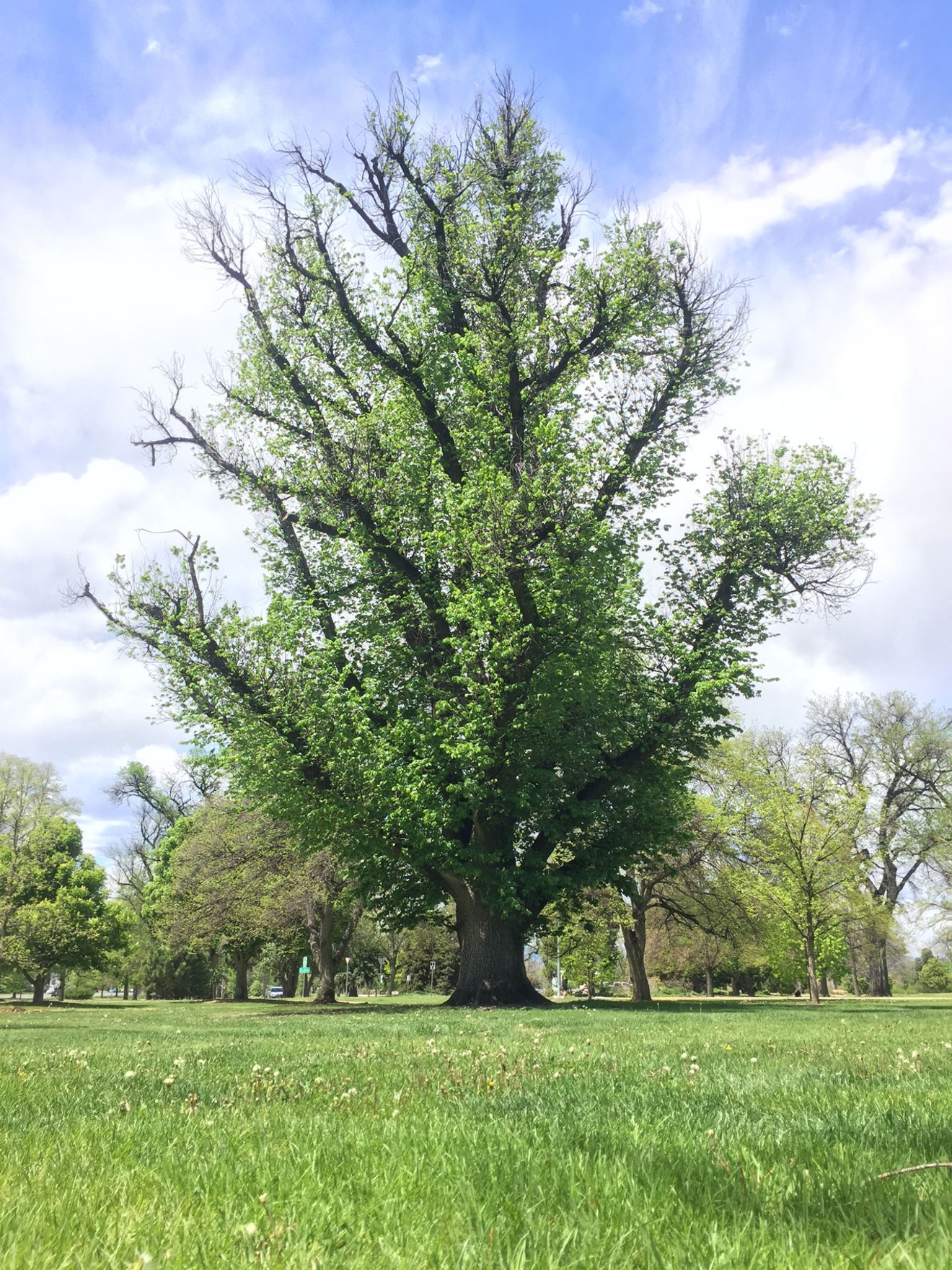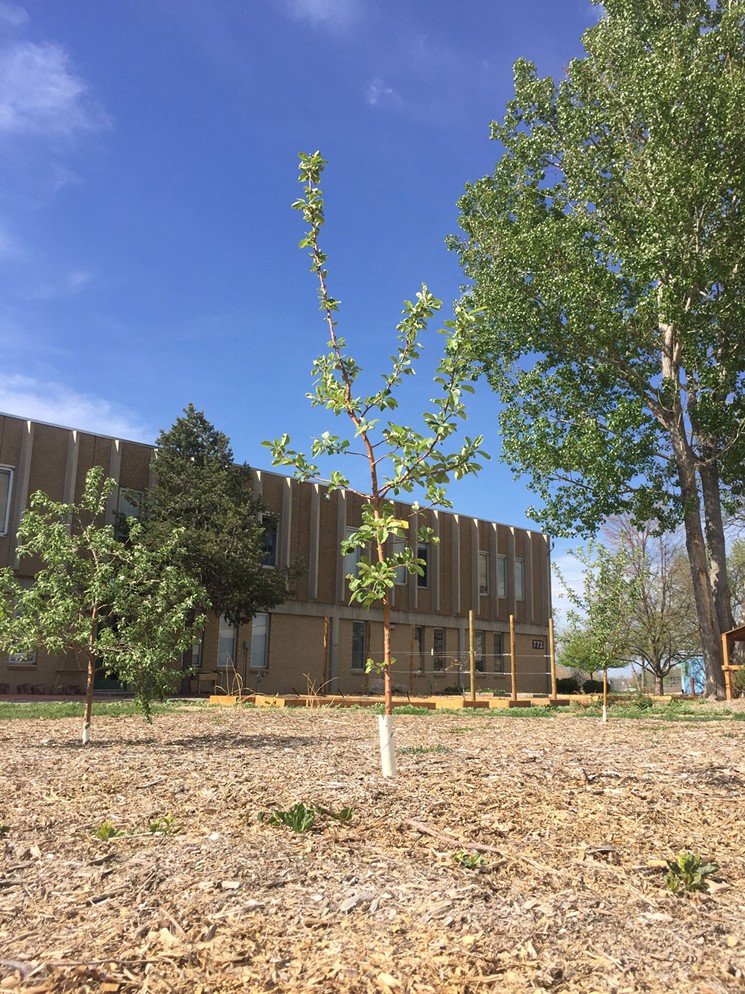Occasionally, a tree even comes with a provenance that makes it close to priceless, like these four in Denver:
Flower of Kent/Isaac Newton Tree
“The saying that the apple doesn’t fall far from the tree is wrong,” says Karl Kister, documentary filmmaker (Rolling Papers, Walden), owner of Denver’s Clear Fork Cider and apparent Renaissance man. “The only way to replicate an apple is to graft it from the original tree.” As a kid, Kister started growing apple trees, and he’s now planted them not only around Colorado, but outside the state, as well. Like children, he explains, the seeds in apples are not clones of their parent tree; if you like the taste of an apple and want to duplicate it, you must take a cutting from the actual tree and hope that it survives. This reality means that every brand of apple you’ve ever tried — Hawthorn, Red Delicious, etc. — was propagated from a single Mother Tree.This rather astonishing fact makes one of Kister’s recent plantings all the more remarkable. In school you no doubt learned that Isaac Newton discovered the law of gravity when an apple fell on his head, but it’s far more likely that Newton observed numerous apples falling from a solitary tree at his home in Woolsthorpe Manor, Kent, where he was hiding out from the Black Death in 1666.
Fast-forward to 2019, and a descendant of that very tree, which inspired both science’s greatest fable and one of its monumental insights, is quietly growing in Lowry, of all places. Known as the Flower of Kent, it was propagated by Scott Skogerboe of the Fort Collins Wholesale Nursery, a man responsible for many of the exotic trees taking root along the Front Range. He gave a cutting to Kister, who settled it at the Logan School for Creative Learning, where future Newtons will relive that fateful discovery as they watch his apples fall in real time.
And could a new cider be on the horizon? It would certainly be the ultimate fruit of knowledge.
Shakespeare Elm
An uncountable number of people have zipped through the intersection of 17th Avenue and Colorado Boulevard over the past 103 years, unaware that a quick craning of the neck to the west would put them in sight of another weighty Englishman: William Shakespeare.That’s because on April 23, 1916, exactly 300 years from the day of the playwright’s death, a cutting of the Wych Elm from Shakespeare’s gravesite at the Holy Trinity Church in Stratford-upon-Avon was planted in the southeast corner of City Park by John Russell, then Denver’s supervisor of parks. Over the last century, the tree has managed to survive both heedless teenagers and the bouts of Dutch elm disease that have felled many of its contemporaries, and it now stands as an unlikely legacy of the world’s greatest poet.
To tree or not to tree? That’s no question at all once you’ve seen this survivor.
Johnny Appleseed Tree
Twenty-five years ago, Scott Skogerboe had just opened a nursery specializing in antique apples. In need of inventory and dogged by nature, he wound up as the unexpected bridge between American folklore and contemporary arboriculture, by way of Sir Isaac Newton and a terrific story.In the early 1990s, Cornell University and the U.S. Department of Agriculture published a list of recommended apple trees, one of which was Newton’s Flower of Kent. Intrigued, Skogerboe connected with the Cornell professor who’d headed the project and who just happened to mention the Johnny Appleseed tree.
As with the tale of Newton’s apple, most children have heard of Johnny Appleseed. Without a doubt the most renowned American nurseryman, he spread fellowship around the eastern Midwest through the careful cultivation of orchards. According to Skogerboe, however, the trees that he planted yielded low-grade apples that were generally inedible (though they did make a commendable alcoholic cider). Because of their fruit’s bitter taste, the trees were frequently left to die, and they became difficult to find.
Skogerboe’s thread-pulling led him to a 1961 story in the Cleveland Plain Dealer on what was thought to be the last known Johnny Appleseed tree, in Ashland, Ohio, where Appleseed had lived around 1821. He contacted a local reference librarian, who told him that the tree had died and put him in touch with its owner.
Over the phone, the old man told Skogerboe that before the tree had died, he’d provided a single cutting to a seventh-grader who had come down from Youngstown, Ohio, decades before on a field trip. Skogerboe contacted the relevant school district, asking for information on the former student who’d collected a cutting from the only known Johnny Appleseed tree. This led, however improbably, to the teacher who’d accompanied the boy on that field trip, and now knew him as the owner of an orchard and an apple pie shop in the area.
Skogerboe called the shop’s owner, a taciturn baker named Bill who didn’t seem interested in chatting. Bill did confirm, however, that the tree still lived, just outside his bakery. After a few discouraging minutes of trying to learn more, Skogerboe finally asked Bill if the apples were good for eating or baking. The response was a frank, “No. They’re good for chucking at cats.”
He secured a cutting of the tree from the man, and a valuable connection to America’s past was saved.
Skogerboe planted the tree in his back yard in Fort Collins, where, twenty-something years later, it still stands but he no longer lives. Still, in the spirit of Johnny Appleseed, over the years Skogerboe has provided cuttings to anyone who asked. They proved so popular that a sapling once sold for $500 in a bidding war at the Denver Botanic Gardens, and nurseries in Washington and Oregon began propagating from his cuttings.
One person he provided with a scion was Jim Tolsrup at the High Plains Environmental Center in Loveland, where Tolsrup is cultivating his own antique and historic apple orchard. It includes, among many other types of trees, Flowers of Kent and the even rarer Hun Hai Tung crabapple from a Buddhist stupa in China.
Skogerboe still makes cuttings of the Johnny Appleseed tree available, as long as you leave the poor cats out of it.
Washington Elm
Near the midpoint of Washington Park grows an inexplicable irony.On July 3, 1775, legend has it, George Washington assumed command of the American Army under a particular white elm in Cambridge, Massachusetts. While this story was never fully vetted, by the 1800s both the site and the tree had become part of the American mythos, symbols of American patriotism.
When the 200-year-old tree collapsed, in 1923, the frantic effort to rescue it saw cuttings sent around the country. According to Sonia John, author of The Washington Park Tree Guide and curator of woody plants at Regis University Arboretum, the Denver chapter of the Daughters of the American Revolution obtained one, as did the City of Loveland. The latter tree thrived, and today it towers over a Walgreens parking lot at 205 East Eisenhower Boulevard in Loveland. In Denver, the DAR planted the cutting in the newly created (and apropos) Washington Park.
When Dutch elm disease ravaged the city in the 1960s and ’70s, the tree in Washington Park succumbed. As John tells it, the dead tree stood for years, until the Daughters finally took action to replace it in 1983.
Understandably, they avoided another elm, instead selecting a hearty specimen that to this day stands sentinel in the south end of the meadow over the sunny, free citizens below.
But while the Daughters must be commended for giving Denver a beautiful tree, it remains a vexing mystery as to why, of all things, they selected an English oak.
There’s hope for a Washington elm in Denver’s future, however, as a tiny sapling is currently growing in a container at the Denver Botanic Gardens, slated for a permanent home in the Rock Alpine Garden. It was propagated from the Washington elm in Loveland. Any guesses by whom?
That’s right: Scott Skogerboe.
















